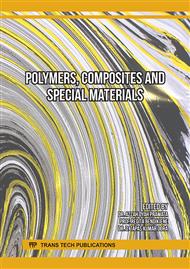[1]
D. Banerjee, J.C. Williams, Perspectives on titanium science and technology, Acta Mater. 61(3) (2013) 844-879
DOI: 10.1016/j.actamat.2012.10.043
Google Scholar
[2]
P. Pushp, S.M. Dasharath, C. Arati, Classification and applications of titanium and its alloys, Mater. Today: Proc. 54 (2022) 537-542
DOI: 10.1016/j.matpr.2022.01.008
Google Scholar
[3]
C. Chunxiang, B. Hu, L. Zhao, S. Liu, Titanium alloy production technology, market prospects and industry development, Mater. Des. 32(3) (2011) 1684-1691
DOI: 10.1016/j.matdes.2010.09.011
Google Scholar
[4]
G. Crowley, How to extract low-cost titanium, AM&P. 161 (2003) 25-27.
Google Scholar
[5]
A.G. Ermachenko, R.Ya. Lutfullin, R.R. Mulyukov, Advanced technologies of processing titanium alloys and their applications in industry, Rev. Adv. Mater. Sci. 29(1) (2011) 68-82.
Google Scholar
[6]
V.A.R. Henriques, Titanium production for aerospace applications, JATM. 1 (2009) 7-17
DOI: 10.5028/jatm.2009.01010717
Google Scholar
[7]
R.R. Boyer, R.D. Briggs, The use of β titanium alloys in the aerospace industry, JMEP. 14 (2005) 681-685
DOI: 10.1361/105994905X75448
Google Scholar
[8]
W. Zhu, L. Peng, G. Ma, T. Cheng and O.M. Ivasishin, Preparation and mechanical properties of powder metallurgy Ti-3Al-2.5V alloy, 2021 IOP Conf. Ser.: Earth and Environmental Science. 692 (2021) 032087. https://iopscience.iop.org/article/
DOI: 10.1088/1755-1315/692/3/032087
Google Scholar
[9]
V.S. Moxson, O.N. Senkov, F.H. Froes, Innovations in titanium powder processing, JOM. 52 (2000) 24-26. https://link.springer.com/article/
DOI: 10.1007/s11837-000-0027-y
Google Scholar
[10]
C.G. McCracken, C. Motchenbacher, D.P. Barbis, Review of titanium-powder-production methods, Int. J. Powder Metall. 46(5) (2010) 19-26.
Google Scholar
[11]
H. Wang, Z. Fang, P. Sun, A critical review of mechanical properties of powder metallurgy titanium, Int. J. Powder Metall. 46.5 (2010) 45-57.
Google Scholar
[12]
IH. Oh, N. Nomura, N. Masahashi, and S. Hanada, Mechanical properties of porous compacts prepared by powder sintering, Scr. Mater. 49(12) (2003) 1197-1202
DOI: 10.1016/j.scriptamat.2003.08.018
Google Scholar
[13]
F.H. Froes, A historical perspective of titanium powder metallurgy, Powder Metall. 1 (2015) 1-1-19
DOI: 10.1016/B978-0-12-800054-0.00001-0
Google Scholar
[14]
V. Savich, A. Taraykovich, S. Bedenko. Improved porous sponge titanium aerators for water treatment, Powder Metall. 56(4) (2013) 272-275.
DOI: 10.1179/0032589913z.000000000125
Google Scholar
[15]
M. Kolbe, V. Lapkovskis, V. Mironovs, V. Zemchenkov, A. Shishkin, Applications of pulsed electromagnetic fields in powder materials, in: Proc. the 6th International Conference on High Speed Forming, Daejeon, Südkorea, 05 (2014) 26-29
Google Scholar
[16]
V. Mironovs, I. Boiko, M. Kolbe, Application of pulse electromagnetic field for joining powder details, in: The 9th International Conference on Mechatronic Systems and Materials MSM-2013, Vilnius, Lithuania. (2013) 170-172.
Google Scholar
[17]
V.A. Glushenkov, and V.F. Karpuhin, Technology of Magnetic Pulse Processing, Publishing house "Fedorov"; Samara, Russia, 2014. (In Russian)
Google Scholar
[18]
V. Mironovs, A. Korjakins, A. Tatarinov, E. Barone, and V. Glushchenkov, Combined static-dynamic compaction of metal powder and ceramic materials, 2017 IOP Conf. Series: Materials Science and Engineering 251 (2017) 012020. https://iopscience.iop.org/article/
DOI: 10.1088/1757-899x/251/1/012020
Google Scholar
[19]
B. Chelluri, E. Knoth, Powder forming using dynamic magnetic compaction, in: 4th International Conference on High Speed Forming, March 9th-10th 2010 Columbus, Ohio, USA, p.pp.26-34
Google Scholar
[20]
S. Woodward, Production of low-volume aviation components using disposable electromagnetic actuator, J. Mater. Process. Techn. 211(5) (2011) 886-895
DOI: 10.1016/j.jmatprotec.2010.07.020
Google Scholar
[21]
T.J. Vogler, M.Y. Lee, D.E. Grady, Static and dynamic compaction of ceramic powders, Int. J. Solids Struct. 44.2 (2007) 636-658
DOI: 10.1016/j.ijsolstr.2006.05.001
Google Scholar



